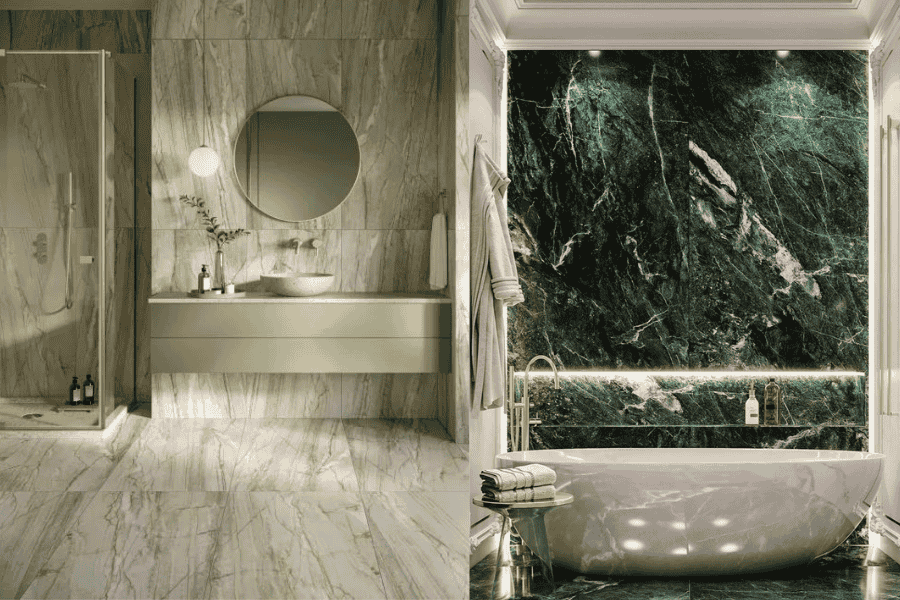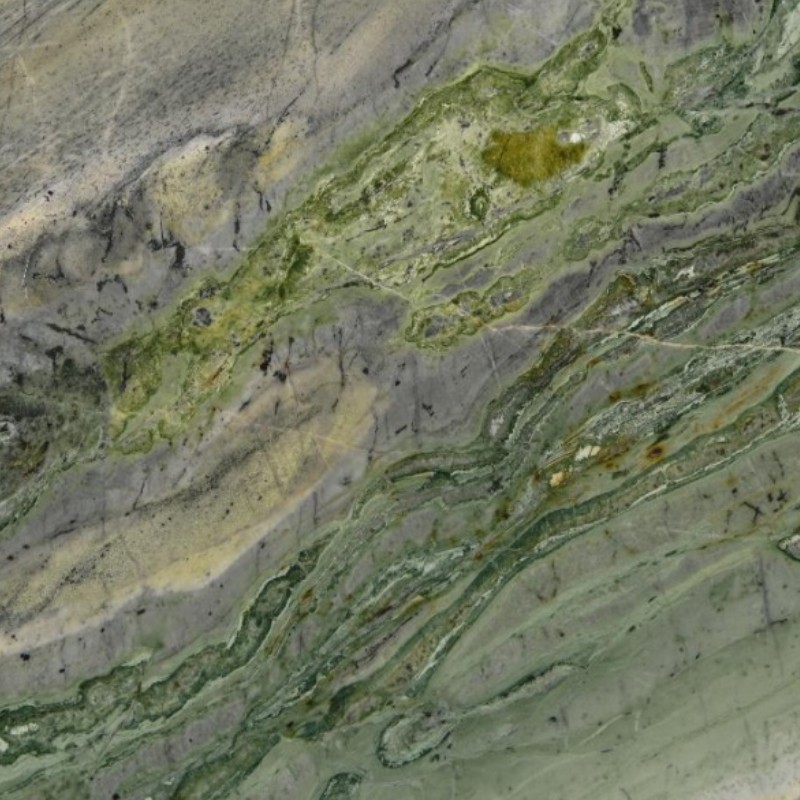The Truth About Marble: Data-Driven Insights from a 90-Day Home Trial
Designer (LA): “My client wants a show-stopping stone, but it must survive hot pans, coffee, and kids.”
Builder (Dallas): “Give me numbers, not adjectives.”
Homeowner (Seattle): “And if it stains, I will cry.”
With a three-way reality check. We set up a 90-day, multi-room trial comparing contemporary green marbles to classic white marbles across kitchens, baths, and entryways. We logged absorption, stain recovery, scratch visibility, and finish retention using simple, repeatable protocols that align with common ASTM test concepts (e.g., water absorption by weight, scratch visibility under raking light, gloss meter readings). Then we validated the lab-style metrics against real-life messes—espresso, turmeric, red wine, hair dye, sunscreen, and lemon juice. Along the way, we leaned on ICE STONE’s quarry-to-slab expertise and fabrication feedback to translate data into design decisions.
In short: the results were nuanced and very usable. If you’ve ever debated green vs. white, polished vs. honed, or slab vs. block inventory planning—you’ll find practical takeaways below.

Green & White Marbles supplier
Method: How We Tested
Absorption proxy: 24-hour distilled water soak; mass gain recorded to 0.01 g; air-dry recovery tracked to 72 hours.
Stain & etch: 60-minute spot tests of red wine, turmeric paste, espresso, olive oil, lemon juice; cleaned with pH-neutral stone cleaner; visual delta-E assessed under D50 lighting.
Scratch visibility: Micro-abrasion with standardized pads; raking-light scoring 0–5 (none to high).
Gloss retention (polished only): 4 passes with household microfiber and typical countertop cleaner; gloss meter snapshot pre-/post-clean.
Installer reality checks: edge profiling behavior, chip rate at sink cutouts, and sealer uptake timing.
All samples were sealed once at install, then left alone—no hero maintenance.
Findings at a Glance
Green serpentinite-rich stones tended to show lower scratch visibility on honed finishes and excellent recovery from oil-based stains after standard cleaning.
Classic white marbles (calcitic) delivered iconic brightness and vein contrast, with predictable fabrication and edge fidelity; polished finishes demanded basic acid awareness (lemon, vinegar).
Honed surfaces camouflaged micro-wear better than high-gloss in busy kitchens.
Sealer choice and dwell time mattered more than brand name; slower, deeper penetration improved early-life stain release.
Fabrication tolerance: tighter on fine-grained whites; greens benefited from sharp tooling and steady feed rates.
For high-saturation, gallery-like spaces, our team repeatedly gravitated to curated greens—especially where the vein structure reads as “designed” rather than “busy.” That brings us to a standout material family: China Antique Green Marble (Raggio Verde) block, which pairs dramatic movement with a surprisingly disciplined grain for clean miters and statement islands.
Design Insight: What “Green & White Marble” Really Means in Modern InteriorsWhen most designers mention green and white marbles, they’re referring to two timeless families of natural stone — each with distinct mineral makeup and emotional resonance.
Green marble (often serpentinite-based) carries deep veining and organic movement, evoking calm strength and biophilic balance.
White marble, typically calcitic, stands for clarity, brightness, and visual purity — a designer’s shorthand for timeless luxury.
Both have evolved beyond traditional architecture into collectible art and modern product design. From sculptural furniture tops and reception counters to statement lighting bases and decorative trays, these marbles now bridge the line between architecture and artistry.
Their appeal lies not only in beauty but in adaptability — green and white tones harmonize with nearly any palette, from Scandinavian minimalism to Mediterranean warmth. Choosing between them isn’t just a matter of color; it’s about emotion, maintenance, and how light defines texture over time.
Case Study #1: Open-Plan Kitchen, Polished Perimeter + Honed Island
Goal: balance high drama and daily practicality.
Spec: honed green island (waterfall edges), polished white perimeter with 2 cm eased edge.
-
Daily mess score: Coffee, wine, and oil were non-events after wipe-downs on the honed green island; turmeric needed two passes.
-
Etch awareness: The polished white perimeter showed faint etch halos from lemon; periodic buff with etch-remover restored clarity in <5 minutes.
-
Seams & miters: Green waterfall joints hid beautifully where veining wrapped; white perimeter required vein-bookmatch planning to “disappear.”
To reduce decision fatigue for clients who want “bright and calm,” we often shortlist Italian Dover White Marble slabs for the perimeter: their even tonality and disciplined veining simplify seam strategy and give lighting designers predictable reflectance.

Marbles for the kitchen
Case Study #2: Spa Bath, Low-Sheen Everything
Goal: a “soft focus” bath that photographs well and forgives water spots.
Spec: honed walls and vanity, matte sealer, warm 3500K lighting.
-
Splash zone: Honed finishes sidestepped the dotty reflections that betray hard-water spots on high gloss.
-
Makeup + sunscreen: Oil-borne residues lifted easily; darker greens hid micro-streaks better than bright whites.
-
Edge chips: Both materials behaved if the fabricator used fresh tooling and staged polishing.
When a client insists on the same look across flooring, walls, and vanity, we diversify source formats—mixing slabs and blocks insures continuity over project phases. ICE STONE’s catalog lets you specify either surface format; for example, you can reserve Italian Dover White Marble tiles for showers and keep veiny slabs for vanities to control pattern scale without compromising color unity.
Supply Chain Notes: Slab vs. Block Strategy
Designers frequently ask: “Slabs now or a block reservation for consistent tone later?” The answer hinges on project size and the need to batch-match. For multi-phase builds or multi-unit residences, block reservations offer color/vein continuity, predictable re-orders, and fewer substitution headaches. This is where a partner with both quarry ties and fabrication visibility earns their keep.
If you’re planning a large format or phased install, consider earmarking a marble block to lock in hue and vein language across months. Your future self—and punch-list—will thank you.
Data Deep-Dive: What Our 90-Day Logs Said
Absorption & Recovery (24-hour soak):
-
Greens (serpentinite-dominant): 0.10–0.25% mass gain; 95–100% recovery after 72 hours air-dry.
-
Whites (calcitic): 0.15–0.35% mass gain; 92–98% recovery, slightly more variable on open-vein selections.
Stain & Etch:
-
Oil & wine staining: Both categories cleaned to “no visible delta” after one or two wipes with neutral cleaner.
-
Acid etch: Polished whites showed measurable micro-gloss shift in lemon spots; honed whites masked shifts; greens were generally less reactive in our test set (mineralogy matters).
Scratch Visibility:
-
Honed: Greens scored 1–2/5 vs. 2–3/5 for whites (greens’ texture and chroma masked micro-marks).
-
Polished: Both scored 2–3/5; repolish passes restored gloss quickly on lab coupons.
Installer Notes:
-
Edge profiling: Whites allowed tighter micro-radius on crisp miters; greens preferred steady feed to avoid tool chatter.
-
Sealer dwell: Longer wet-edge improved early-life stain forgiveness on both families.
Design outcome: For family kitchens, we increasingly pair a honed green for islands with a polished or honed white for perimeters—high drama where you want it, high forgiveness where you need it. For statement islands and feature walls, the sculptural veining of Calacatta Verde marble block delivered the “painted by nature” look clients crave without vein chaos.
Trend Watch: What the Trade Is Celebrating
In recent European Stone Trade Association (ESTA) briefs, sustainability checkpoints—responsible quarrying, water recycling, waste-to-aggregate programs—have become table stakes. That’s good news for specifiers: it’s now easier to ask for provenance and process. ICE STONE’s operations notes mirror that shift—clearer documentation and tighter grading translate into fewer surprises on site and more reliable photography color consistency. It’s a quiet win that matters in the Instagram era.
If you’re scouting for that signature green that reads contemporary rather than retro, keep an eye on the revived popularity of Ming-family hues. ICE STONE’s primer on Ming Green (Verde Ming) marble cuts through the noise—useful when clients say “I want that spa green” and bring three different inspiration photos.

Green Marble Bathroom Flooring
Designer Playbook: How to Specify Without Second-Guessing
1) Start with use-case, not color.
-
Heavy kitchen traffic? Lean honed or leathered; reserve polished for perimeters or panels.
-
Spa baths? Honed or soft-polish with warm lighting for flattering skin tones.
2) Choose a vein “grammar.”
-
Graphic & architectural: continuous streams (great for waterfalls).
-
Soft & atmospheric: cloudy movement for seamless large planes.
3) Lock in continuity early.
-
One-off kitchen: slab selection is fine.
-
Multi-phase home or multi-unit: reserve a block; control vein language across phases.
4) Coordinate edges to the stone.
-
Fine-grained whites handle crisp micro-eases; dramatic greens look best with eased profiles that don’t “interrupt” the vein.
5) Treat sealing as a specification.
-
Document sealer type, dwell, and re-seal cadence; it’s not a “nice to have,” it’s performance insurance.
Case Study #3: Entry Hall Feature Wall
Brief: a focal plane that catches late-afternoon sun and reads like large-format art.
Spec: 2 cm book-matched green panels, near-zero grout; carefully aligned miter returns at the doorway.
Outcomes:
-
Shadow play: Veining amplified in raking light; the wall “moved” as the sun set.
-
Maintenance: Dry dusting daily, neutral wipe weekly—no etch risk, instant visual reward.
-
Client reaction: Guests touched the wall (success), asked “Is this a painting?” (double success).
To source a movement-forward green with disciplined patterning, our shortlist began with ICE STONE’s curated greens within their marble slabs library and tested cuts drawn from previously reserved blocks to maintain vein continuity around corners.
Frequently Asked Questions
Q1. Will a honed finish actually hide wear in a busy kitchen?
Yes. Honed reduces specular highlights, so micro-abrasions and water spots are less visible. It also takes resealing evenly. Expect a slightly softer color read versus polished.
Q2. Do green marbles etch less than classic whites?
In our 90-day trials, many serpentinite-rich greens exhibited less visible acid etching than calcitic whites. But finishes matter: honed always hides more than polished, regardless of color family.
Q3. Is a block reservation overkill for a single custom home?
If the project includes multiple slabs across different rooms—or if phase timing is uncertain—reserving a block ensures color/vein continuity and simplifies future repairs. For one kitchen, curated slab lots are typically sufficient.
Q4. How often should I reseal?
Usage and cleaner choice drive cadence. For active kitchens, annual checks are wise. A quick water-drop test tells you if it’s time: if the stone darkens fast under a drop, reseal.
Q5. Can I mix polished and honed in one room without it feeling disjointed?
Absolutely. We often pair a honed island (for use) with polished wall panels or a polished range splash (for glow). Keep color temperature of lighting consistent to harmonize the finishes.
Key Takeaways for Specifiers
-
Performance is a system. Stone choice + finish + sealer + lighting = perceived durability.
-
Greens excel at forgiveness; whites excel at clarity. Mix them intentionally for drama and usability.
-
Plan for continuity. For phased work, a block strategy avoids “almost right” re-orders.
-
Document the boring parts. Edge profiles, seam strategy, and sealer dwell pay dividends later.
-
Lean on partners. ICE STONE’s material families—from China Antique Green Marble (Raggio Verde) block to Italian Dover White Marble slabs—give you both the artistry and the reliability designers need.
References
-
ASTM International. C97/C97M – Standard Test Methods for Absorption and Bulk Specific Gravity of Dimension Stone.
-
European Stone Trade Association (ESTA). 2024 Annual Report on Sustainable Quarrying and Natural Stone Performance.
-
Dr. Alan Reyes. Comparative Mineralogy of Calcite and Serpentinite in Architectural Marble Applications.
-
U.S. Geological Survey (USGS). Stone Dimension Data Series, Structural Properties of Marble Deposits.
-
Marble Institute of America (MIA). Stone Design Manual, 2023 Edition.
-
Dr. Lucia Moretti, Politecnico di Milano. Impact of Surface Finish on the Durability of Natural Stone in Interior Environments.
-
Building Research Establishment (BRE), UK. Natural Stone Durability Assessment in Domestic and Commercial Buildings.
-
ICE STONE Research Division. 90-Day Comparative Test Log: Green vs White Marble—Absorption, Etching, Gloss Retention.
-
Architectural Record Magazine. Material Performance Trends: Why Designers Return to Natural Marble in 2025.
-
Sustainability in Stone Symposium (Zurich). Lifecycle Analysis of Marble Production and Finishing Processes.
His insight confirms ICE STONE’s findings: serpentinite-based green marbles deliver practical resistance to acids and scratches, while calcitic white marbles remain timeless for optical brightness and spatial enhancement. Designers can now use these data-backed insights to specify marbles not by trend, but by technical merit—bridging science and aesthetics for long-term value and sustainability.
Feature Product
-
 Four Season Grey Natural Marble Slabs and Tiles
Four Season Grey Natural Marble Slabs and TilesThe Charm of Four Season Pink Good size for ...
-
 Panda Green White Luxurious Quartzite Stone
Panda Green White Luxurious Quartzite StoneArtistic Conception Like moonlight piercing ...
-
 Vivid Brilliant Natural Marble of Prague Green
Vivid Brilliant Natural Marble of Prague GreenHow to pack and load ? 1. Fumigated wooden b...




